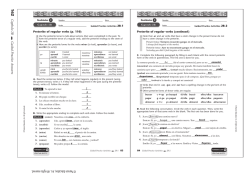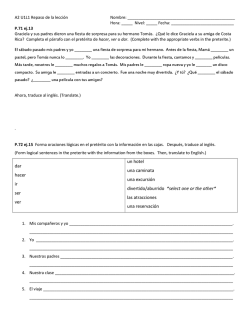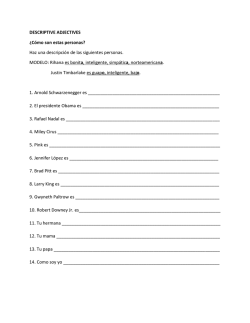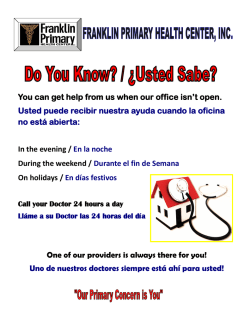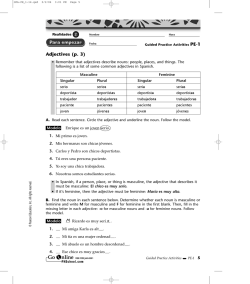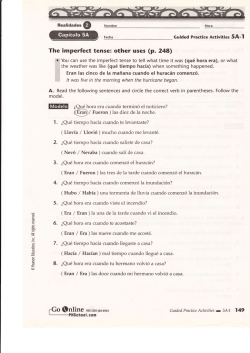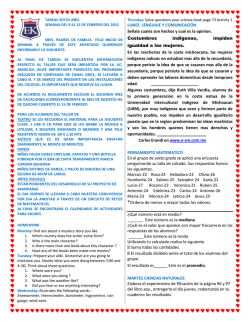
¿Qué ropa compraste?
Level 2 Costa Rica ¿Qué ropa compraste? Realidades 2 Capítulo 2B La República Dominicana GPA2B_71-89.qxd 2/2/06 3:11 PM Page 71 Realidades Nombre Hora Fecha AVSR 2B-1 Cardinal numbers (p. 99) • Cardinal numbers are used for counting and for telling quantities of things. Remember that uno and cientos change to agree in gender with the nouns that follow them. treinta y un perros thirty-one dogs seiscientas personas six hundred people A. Match the series of numbers on the left with the numerals on the right. 1. ______ mil ochocientos setenta y tres a. 2104 2. ______ cinco mil quinientos b. 1707 3. ______ mil setecientos siete c. 1873 4. ______ mil cuatrocientos noventa y dos d. 5500 5. ______ dos mil ciento cuatro e. 1928 6. ______ mil novecientos veintiocho f. 1492 B. Write the numbers indicated numerically. Follow the model. Modelo ciento cuarenta y seis 146 1. trescientos treinta y tres © Pearson Education, Inc. All rights reserved. 2. mil ochenta y cinco 3. dos mil novecientos 4. quinientos setenta y seis 5. ciento cuarenta y cuatro mil 6. doscientos noventa y ocho 7. cincuenta mil veinticinco 8. nueve mil seiscientos treinta WEB CODE jdd- 0211 A ver si recuerdas 2B-1 71 ! P102 Act1 ¿Dónde está? jdd-0297 1. _____ C 2. _____ D 3. _____ 4. _____ 5. _____ 6. _____ G 7. _____ F A E B P103 Act2 ¿Cierto o falso? jdd-0297 1. ! " 2. ! " 5. ! " 6. ! " ! ! 3. ! " 7. ! " 4. ! " P105 Act3 ¿Comprendiste? 1. ________________________________________________________________ 2. ________________________________________________________________ 3. ________________________________________________________________ 4. ________________________________________________________________ 5. ________________________________________________________________ 6. ________________________________________________________________ 7. ________________________________________________________________ ! P106 Act5 ¿Cierta o falsa? 1. C F ________________________________________________________________ 2. C F ________________________________________________________________ 3. C F ________________________________________________________________ 4. C F ________________________________________________________________ 5. C F ________________________________________________________________ 6. C F ________________________________________________________________ P107 Act7 ¿Qué compran y cómo pagan? P109 Fondo cultural ! ! ___________________________________________________________________________ ___________________________________________________________________________ ____________________________________________________________________ P109 Act11 Juego: ¿Quién es? Mis puntos: ! Los puntos de mi compañero(a): P109 Act12 Y tú, ¿qué dices? ! 1. _____________________________________________________________________ _______________________________________________________________________ 2. _____________________________________________________________________ ______________________________________________________________________ 3. _____________________________________________________________________ ______________________________________________________________________ 4. _____________________________________________________________________ _______________________________________________________________________ P110 Act13 ¡Gracias por el regalo! ! 1. __________________ 2. __________________ 7. __________________ 3. __________________ 8. __________________ 4. __________________ 9. __________________ 5. __________________ 10. __________________ 6. __________________ 11. __________________ GPA2B_71-89.qxd 2/2/06 3:11 PM Page 83 Realidades Nombre Hora Fecha Guided Practice Activities 2B-1 Preterite of regular verbs (p. 110) • Use the preterite tense to talk about actions that were completed in the past. To form the preterite tense of a regular verb, add the preterite endings to the stem of the verb. • Here are the preterite forms for the verbs mirar (to look), aprender (to learn), and escribir (to write): yo miré aprendí escribí nosotros/ nosotras miramos aprendimos escribimos we looked we learned we wrote tú miraste you looked aprendiste you learned escribiste you wrote vosotros/ vosotras mirasteis aprendisteis escribisteis you looked you learned you wrote usted/ él/ella miró aprendió escribió ustedes/ ellos/ellas miraron aprendieron escribieron you/they looked you/they learned you/they wrote I looked I learned I wrote you/he/she looked you/he/she learned you/he/she wrote A. Read the sentences below. If they tell what happens regularly in the present (using the present tense), write a 1. If they tell what happened in the past (using the preterite tense), write a 2. Follow the model. Modelo 2 Yo aprendí a leer. 1. Tú miraste el letrero. 2. Mi papá escribió un cheque. © Pearson Education, Inc. All rights reserved. 3. Las chicas estudian mucho en la clase. 4. Uds. escriben el libro. 5. Yo miré la tele anoche. B. Write the appropriate ending to complete each verb stem. Follow the model. Modelo (comer) Nosotros com imos en la cafetería. 1. (aprender) Uds. aprend a leer en la escuela. 2. (escribir) Yo no escrib la carta. 3. (aprender) Carlos y yo aprend 4. (mirar) Rafael no mir 5. (enviar) Mis abuelos me envi 6. (comer) Tú com 7. (preparar) Mi padre prepar WEB CODE jdd- 0214 el inglés. el precio de la camisa. una carta. con Antonio anoche, ¿verdad? la comida. Guided Practice Activities 2B-1 83 GPA2B_71-89.qxd 2/2/06 3:11 PM Realidades Page 84 Nombre Hora Fecha Guided Practice Activities 2B-2 Preterite of regular verbs (continued ) • Note that -ar and -er verbs that have a stem change in the present tense do not have a stem change in the preterite. Present tense: Siempre encuentro gangas en el mercado. I always find bargains at the market. Preterite tense: Ayer no encontraste gangas en el mercado. Yesterday you didn’t find bargains at the market. C. Complete the following paragraph by filling in each blank with the correct preterite form of the verb in parentheses. The first one is done for you. fuí La semana pasada yo (ir) al centro comercial, pero yo no (encontrar) una camiseta de mi talla porque soy grande. Mi mamá también buscó la camiseta ayer pero (costar) mucho dinero. Recientemente, me (probar) una camiseta apretada y no me gustó. Esta mañana nosotros (despertarse) temprano para ir de compras. ¡Qué bien, porque yo (volver) a la tienda y compré mi camiseta! • Verbs that end in -car, -gar, and -zar have a spelling change in the yo form of the preterite. • Other preterite forms of these verbs are regular. buscar c➔qu yo busqué él/ella buscó ellos/ellas buscaron pagar g➔gu yo pagué él/ella pagó ellos/ellas pagaron yo almorcé él/ella almorzó ellos/ellas almorzaron almorzar z➔c 1. JUAN: ¿Buscaste una camisa nueva? EMILIO: Sí, yo busqué una camisa nueva. Tere zapatos. 2. JUAN: ¿Pagaste la camisa en efectivo? EMILIO: Sí, yo en efectivo. Miguel con tarjeta de crédito. 3. JUAN: ¿Almorzaste con Elena en el restaurante? EMILIO: Sí, yo con Elena. Nosotros a las dos. 4. Juan: ¿Llegaste temprano a la tienda? Emilio: Sí, yo 84 Guided Practice Activities a las nueve. Emilia y Víctor 2B-2 tarde. WEB CODE jdd- 0214 © Pearson Education, Inc. All rights reserved. D. Read the following conversation. Circle the verb in each question. Then, write the appropriate form of that same verb in the blank. The first one has been done for you. P111 Act15 part 1 La última vez ! 1. _____________________________________________________________________ 2. _____________________________________________________________________ 3. _____________________________________________________________________ 4. _____________________________________________________________________ 5. _____________________________________________________________________ 6. _____________________________________________________________________ 7. _____________________________________________________________________ 8. _____________________________________________________________________ P112 Act16 Muchas actividades ! 1. __________________________________________________________________ 2. __________________________________________________________________ 3. __________________________________________________________________ 4. __________________________________________________________________ 5. __________________________________________________________________ 6. __________________________________________________________________ 7. __________________________________________________________________ P113 Exploración del lenguaje: Origins of words from Arabic ! 1. __________________________________________________________________ 2. __________________________________________________________________ GPA2B_71-89.qxd 2/2/06 3:11 PM Page 85 Realidades Nombre Hora Fecha Guided Practice Activities 2B-3 Demonstrative adjectives (p. 114) • Demonstrative adjectives show how close something is to the speaker. Here’s a chart that compares the demonstrative adjectives: Singular Plural este/esta this estos/estas these ese/esa that esos/esas those aquel/aquella that (over there) aquellos/aquellas those (over there) A. Write the equivalent word(s) in English for each underlined demonstrative adjective. Follow the model. Modelo Me gustan aquellas camisas blancas. English: those (over there) 1. Yo prefiero estas camisas rojas. English: 2. A mí me gusta esta gorra roja. English: 3. Yo quiero comprar esos zapatos. English: 4. A mi madre le gusta aquella blusa elegante. English: 5. Ella compró ese bolso cuando fue a París. English: B. Circle the correct demonstrative adjective in parentheses to complete the dialogue. Remember adjectives must agree in gender and number with the noun they describe. LUPE: Mamá, ¡mira ( este / esta ) suéter de lana! Es perfecto para papá. © Pearson Education, Inc. All rights reserved. MADRE: Sí, pero él prefiere ( esos / esas ) pantalones azules allí. Son más prácticos. LUPE: ¡Oh! Quiero comprar ( aquellos / aquellas ) faldas bonitas cerca de la ventana. MADRE: Me gustan, pero ( este / esta ) falda es tu número, el dos. LUPE: Pero no va bien con ( ese / esa ) camisa que me gusta, la roja. MADRE: Entonces, prueba las dos. LUPE: Bien. Gracias, mamá. WEB CODE jdd- 0215 Guided Practice Activities 2B-3 85 GPA2B_71-89.qxd 2/2/06 3:11 PM Realidades Page 86 Nombre Hora Fecha Guided Practice Activities 2B-3a Demonstrative adjectives (continued ) C. Look at the pictures of clothing below. Then, answer the question by writing in the correct demonstrative adjective for each article of clothing. The smallest article of clothing is the farthest away. Follow the model. Modelo —¿Qué falda prefieres? aquella falda. —Prefiero 1. —¿Qué camisa vas a comprar? —Voy a comprar camisa. 2. —¿Qué pantalones te gustan? —Me gustan pantalones. 3. —¿Qué traje prefieres? —Prefiero 4. —¿Qué zapatos piensas comprar? —Pienso comprar zapatos. traje. 1. (this) Debes leer 2. (those over there) ¿Quiénes son 3. (that) ¿Leíste 4. (these) ¿De quiénes son 5. (this) No me gusta 86 Guided Practice Activities 2B-3a libro. Es muy interesante. señoritas? novela antes? cheques de viajero? lápiz. Prefiero uno azul. WEB CODE jdd- 0215 © Pearson Education, Inc. All rights reserved. D. Write the correct demonstrative adjectives based on the English cues you are given. P114 Act19 ¿Esta corbata o aquella corbata? ! 1. ____________ 2. ____________ 3. ____________ 4.____________ 5._____________ 6. _____________ ! P114 Act20 Escucha y escribe jdd-0298 1. Al lado de cerca de lejos de 2. Al lado de cerca de lejos de 3. Al lado de cerca de lejos de 4. Al lado de cerca de lejos de 5. Al lado de cerca de lejos de 6. Al lado de cerca de lejos de 7. Al lado de cerca de lejos de 8. Al lado de cerca de lejos de P115 El espanol en el mundo del trabajo ! Answer the questions: _____________________________________________________________________ _______________________________________________________________________ _______________________________________________________________________ _______________________________________________________________________ GPA2B_71-89.qxd 2/2/06 3:11 PM Page 87 Realidades Nombre Hora Fecha Guided Practice Activities 2B-4 Using adjectives as nouns (p. 116) • When you compare two similar things, you can avoid repetition by dropping the noun and using the article ! the adjective for the second thing. ¿Cuál prefieres, el vestido apretado o el flojo? Which do you prefer, the tight dress or the loose one? Prefiero el flojo. I prefer the loose one. A. Read the questions below. Circle the noun in each question. Then, answer the questions using the appropriate article and adjective as a noun. Modelo ––¿Pagaste el precio alto o el bajo? ––Pagué el bajo . 1. ––¿Compraste la blusa clara o la oscura? ––Compré . 2. ––¿Probaste los zapatos caros o los baratos? ––Probé . 3. ––¿Encontraste el vestido grande o el mediano? ––Encontré . 4. ––¿Te gustan los jeans apretados o los flojos? © Pearson Education, Inc. All rights reserved. ––Me gustan . B. Read the sentences below. Complete the second sentence in each pair using an article and the opposite adjective as a noun. Choose from the word bank. Follow the model. antipáticos Modelo blanca claro floja largas A Juan le encanta la ropa negra. No le encanta la pequeñas blanca . 1. Nosotros preferimos las tiendas grandes. No preferimos . 2. A ellas les gustan los cajeros simpáticos. No les gustan . 3. Yo no me pruebo la ropa apretada. Me pruebo . 4. Emily no prefiere las faldas cortas. Prefiere 5. No compraste el traje oscuro. Compraste WEB CODE jdd- 0216 . . Guided Practice Activities 2B-4 87 P118 Lectura: ¿Comprendiste? ! _______________________________________________________________________ _______________________________________________________________________ _______________________________________________________________________ _______________________________________________________________________ _______________________________________________________________________ _______________________________________________________________________ _______________________________________________________________________ _______________________________________________________________________ P118 Lectura: Y tú, ¿qué dices? ! _______________________________________________________________________ _______________________________________________________________________ _______________________________________________________________________ _______________________________________________________________________ _______________________________________________________________________ ! P314 Perspectivas del mundo hispano: Compruébalo! 1.______________________________________________________________________ 2.______________________________________________________________________ 3.______________________________________________________________________ P314 Perspectivas del mundo hispano: ¿Qué te parece? ! _______________________________________________________________________ _______________________________________________________________________ _______________________________________________________________________ _______________________________________________________________________ _______________________________________________________________________ _______________________________________________________________________ GPA2B_71-89.qxd 2/2/06 Realidades 3:11 PM Page 88 Nombre Hora Fecha Guided Practice Activities 2B-5 Lectura: Los jeans (pp. 118–119) A. The reading in your textbook is about the history of jeans. Before you read the selection, think about and answer the following questions. 1. Do you like to wear jeans? Why? 2. Why are jeans popular with many students? B. The second section from your textbook reading is about one of the inventors of jeans. Read the selection and answer the questions. Use the Hints below to help you answer the questions. Un poco de historia Levi Strauss, un joven alemán, llegó a los Estados Unidos con su familia en 1847 a la edad de 18 años. Después de trabajar algunos años con su familia, Strauss viajó a California para abrir una tienda de ropa y accesorios. Esta tienda se convirtió en un negocio próspero durante los siguientes 20 años, y Strauss se hizo rico. 1. What type of store did Levi Strauss open in California? Hint: Look for the words una tienda de. 2. What happened over the next 20 years? Hint: Look for the words próspero and rico. 1. When did Levi Strauss arrive in the United States? a. 1873 b. 1847 2. Before Levi Strauss and Jacob Davis began to make waist overalls, they needed a a. patent. b. letter. 3. When Strauss and Davis received the patent, they began to a. make waist overalls. 88 Guided Practice Activities b. explain the process. 2B-5 WEB CODE jdd- 0217 © Pearson Education, Inc. All rights reserved. C. Now, look at the dates and events from the life of Levi Strauss and answer the following questions. 1847: Levi Strauss llegó a los Estados Unidos. 1872: Recibió una carta de Jacob Davis que le explicó un proceso para hacer más fuertes los pantalones. Ellos pidieron la patente de este proceso. 1873: Recibieron la patente y empezaron a fabricar waist overalls. GPA2B_71-89.qxd 2/2/06 3:11 PM Page 89 Realidades Nombre Hora Fecha Guided Practice Activities 2B-6 Presentación escrita (p. 121) Task: You received $200 for your birthday and have just purchased some articles of clothing. Write an e-mail to your friend describing your shopping trip. A. Before you write the e-mail, it would be helpful to organize the information about your purchases. Fill in the table below. The first line is done for you. ¿Qué compraste? ¿Dónde…? camiseta 1. ¿Cuánto pagaste? en el centro comercial $20 2. 3. B. Answer the following questions about your shopping trip. You can look back at your answers in part A to help you. 1. ¿Qué compraste? Yo . 2. ¿Dónde compraste la ropa? Yo . 3. ¿Cuánto pagaste? Yo . © Pearson Education, Inc. All rights reserved. 4. ¿Por qué compraste esta ropa? Yo . C. Use the answers to the questions in parts A and B to write an e-mail to your friend below. You may use the following model. ¡Hola en el Luego, compré ropa? Adiós, ! Yo recibí . Compré en mi cumpleaños. Yo compré ropa . Yo pagué . . Pagué por . está de moda y me gusta mucho. ¿Qué te parece mi D. Check your e-mail for spelling, forms of the preterite, and agreement. Then, send it to your teacher or a classmate. Guided Practice Activities 2B-6 89
© Copyright 2024
